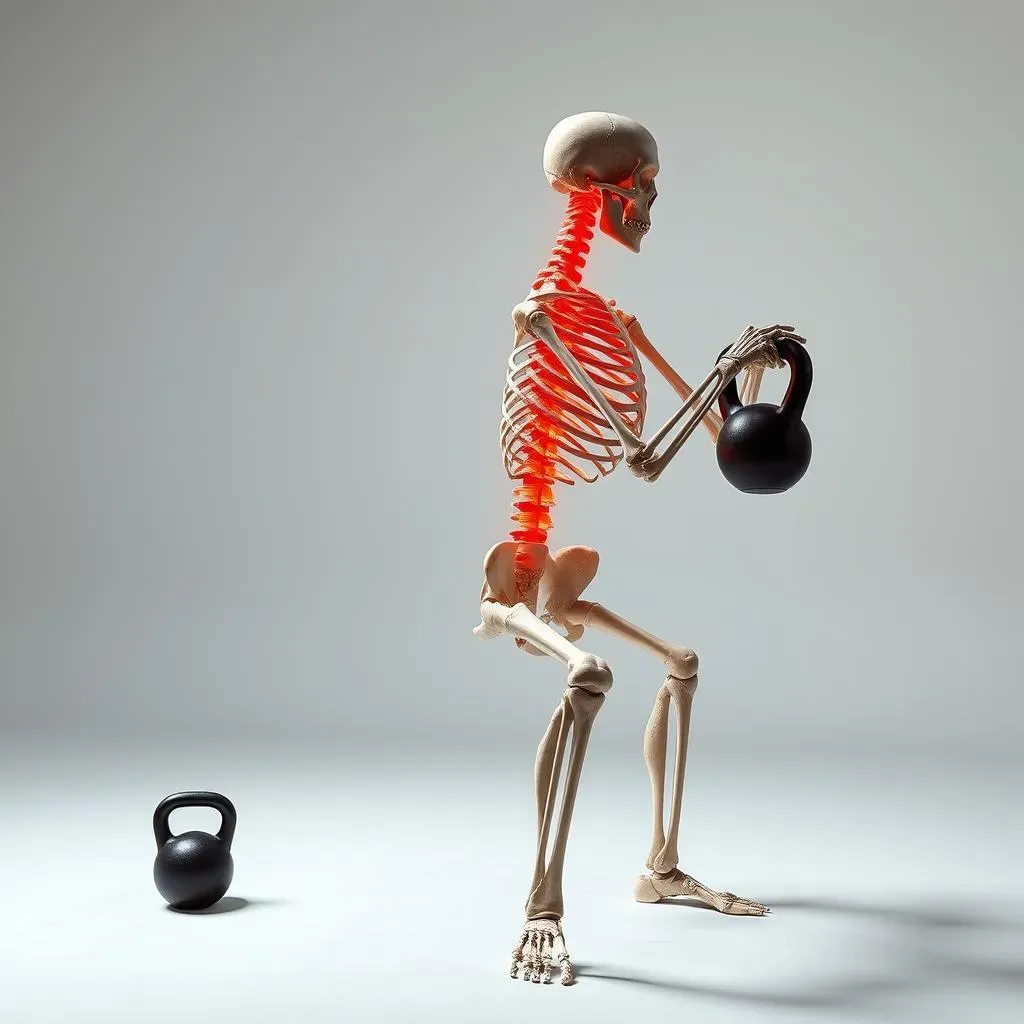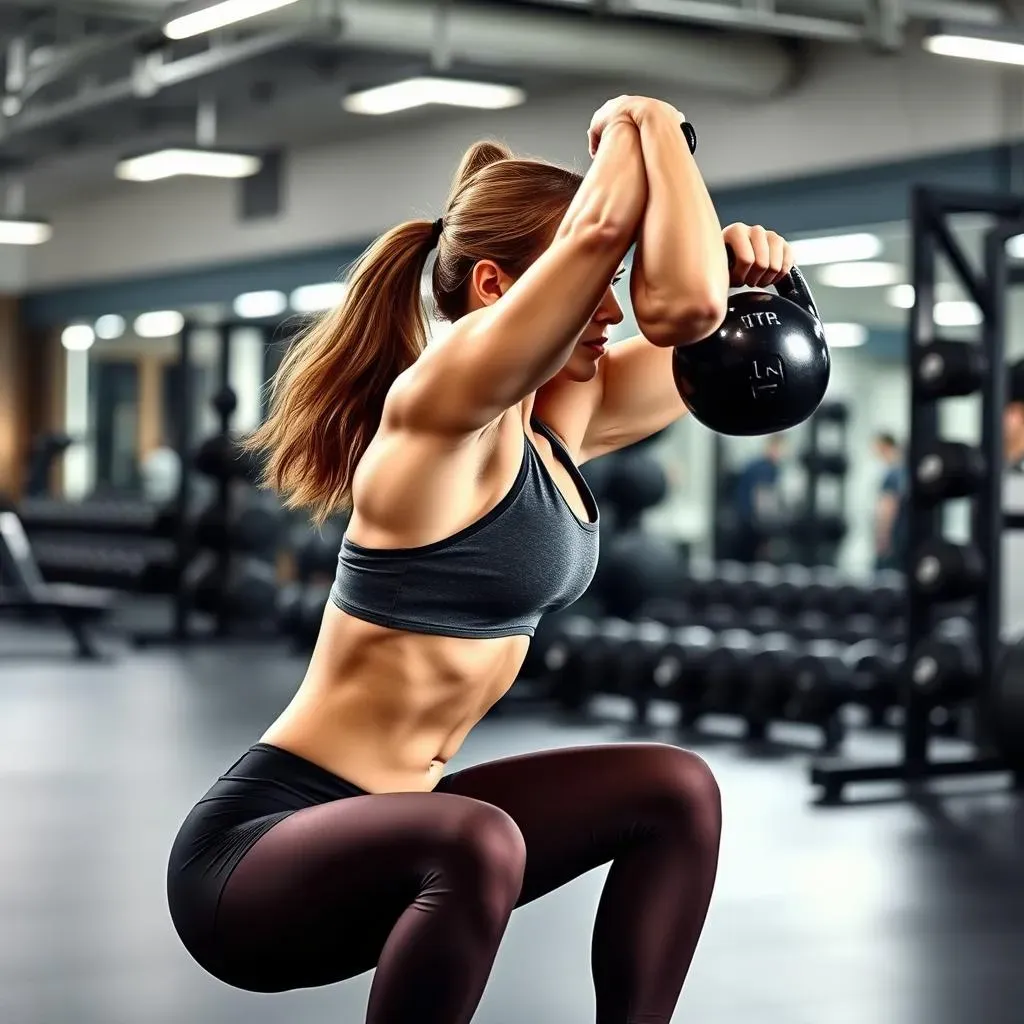Table of Contents
Ready to torch calories and build serious strength? The kettlebell squat shoulder press is your all-in-one ticket to a fitter you. This dynamic exercise combines a lower-body squat with an upper-body press, delivering a full-body workout that's both efficient and effective. Forget endless hours at the gym; this single move targets your legs, glutes, core, and shoulders, maximizing your time and effort. But before you start swinging, it’s crucial to master the proper form. We'll break down the technique step-by-step, highlighting common mistakes to avoid so you can lift safely and effectively. Plus, we'll explore variations to suit every fitness level, from beginner to advanced. Whether you're looking to build muscle, improve your cardio, or simply add some spice to your routine, the kettlebell squat shoulder press has something to offer. So, grab your kettlebell, and let's get started on building a stronger, more powerful you! This guide will equip you with everything you need to know.
Benefits of the Kettlebell Squat Shoulder Press Exercise

Benefits of the Kettlebell Squat Shoulder Press Exercise
Full-Body Powerhouse
The kettlebell squat shoulder press isn't just another exercise; it's a compound movement that works multiple muscle groups simultaneously. You're hitting your quads, glutes, and hamstrings with the squat, while your shoulders, traps, and core are engaged during the press. This means you're not just building strength, but also improving your overall functional fitness. Think about it: you're mimicking real-life movements like lifting a heavy object from the ground and hoisting it overhead. That translates to improved performance in everyday activities, from carrying groceries to lifting luggage.
It's like getting several exercises done in one fluid motion. No more spending hours switching between machines; this exercise is your shortcut to a full-body workout. Plus, the dynamic nature of the movement boosts your heart rate, turning it into a cardio session as well. Who needs the treadmill when you can squat, press, and sweat all at once?
Boosting Strength and Coordination
Beyond building muscle, the kettlebell squat shoulder press significantly enhances your coordination and balance. The exercise requires you to maintain stability throughout the squat and press, forcing your core to work overtime to keep you upright and balanced. This improved stability translates to better posture and reduced risk of injuries, especially in your lower back.
Think of it as a symphony of movement where every muscle plays its part. The squat provides the foundation, the core stabilizes, and the shoulders execute the press. It's not just about lifting weight; it's about controlling the movement, engaging the right muscles, and maintaining your balance. That's what makes it so effective for improving overall strength and coordination.
Metabolic Benefits and Calorie Burn
Looking to shed some pounds? The kettlebell squat shoulder press is your secret weapon. As a compound exercise, it burns a significant number of calories compared to isolation exercises. The combination of strength and cardio makes it a highly effective tool for weight loss and improving your metabolic rate.
The more muscle you build, the more calories you burn at rest. This exercise helps you build lean muscle mass, which in turn boosts your metabolism. You're not just burning calories during the workout; you're turning your body into a calorie-burning machine, even when you're resting. This is particularly beneficial for long-term weight management and overall health. So, ditch the boring cardio and start squatting and pressing your way to a leaner, fitter you!
Proper Form for the Kettlebell Squat Shoulder Press

Proper Form for the Kettlebell Squat Shoulder Press
Stance and Kettlebell Positioning
Before diving into the movement, let's nail the setup. Stand with your feet slightly wider than shoulder-width apart, toes pointing slightly outward. This stance provides a stable base for the squat. Now, grab your kettlebell with both hands, holding it in front of your chest, close to your body. Think of it as hugging the kettlebell – this keeps it secure and prevents it from swinging around, which can throw off your balance. Keep your elbows tucked in and your core engaged; this is your foundation for the entire exercise.
This starting position is crucial because it sets the stage for a controlled and powerful movement. A wobbly start can lead to poor form and potential injuries down the line. So, take your time, find your balance, and make sure you feel solid before you even think about squatting.
The Squat and Press Motion
Now for the fun part: the squat and press! Initiate the movement by pushing your hips back and down, as if you're sitting into a chair. Keep your chest up, back straight, and eyes focused forward. As you descend into the squat, aim to get your thighs parallel to the ground or as low as you comfortably can. Once you reach the bottom of the squat, explosively drive through your heels to stand back up. As you stand, use that momentum to press the kettlebell overhead, fully extending your arms. Think of it as one fluid motion, seamlessly transitioning from the squat to the press.
Control is key here. Avoid rushing the movement; focus on maintaining proper form throughout the entire exercise. The squat should be deep and controlled, and the press should be smooth and powerful. Don't let the kettlebell dictate the movement; you're in charge. A lot of people mess this up, so pay close attention.
Breathing and Core Engagement
Breathing is often overlooked, but it's crucial for maintaining stability and power during the kettlebell squat shoulder press. Inhale deeply as you descend into the squat, filling your lungs with air. As you stand up and press the kettlebell overhead, exhale forcefully. This helps to engage your core and stabilize your spine.
Speaking of core engagement, it's not just about sucking in your gut. Think of it as bracing your entire torso, as if you're about to take a punch to the stomach. This provides a solid foundation for the movement and protects your lower back from injury. A strong core is essential for maintaining proper form and maximizing the benefits of the exercise.
Common Mistakes to Avoid During the Kettlebell Squat Shoulder Press

Common Mistakes to Avoid During the Kettlebell Squat Shoulder Press
Rounding the Back
One of the most common mistakes people make is rounding their back during the squat portion of the exercise. This puts excessive stress on your spine and can lead to serious injuries. To avoid this, focus on maintaining a straight back throughout the entire movement. Keep your chest up, shoulders back, and core engaged. Imagine there's a rod running down your spine, keeping it straight and aligned. If you find yourself struggling to maintain a straight back, it may be a sign that you're lifting too heavy or that your squat depth is too deep. Reduce the weight or modify the exercise to ensure proper form.
Using Momentum Instead of Muscle
Another frequent error is relying on momentum to swing the kettlebell up during the press. This not only reduces the effectiveness of the exercise but also increases the risk of injury. The press should be powered by your shoulder muscles, not by a jerky, uncontrolled movement. To correct this, slow down the exercise and focus on engaging your shoulder muscles to lift the kettlebell. Control the weight throughout the entire range of motion, both on the way up and on the way down. If you find yourself using momentum, it's a sign that you need to reduce the weight or focus on strengthening your shoulder muscles with isolation exercises.
Not Engaging the Core
Failing to engage the core is another common mistake that can lead to instability and injury. Your core muscles are essential for maintaining balance and supporting your spine during the kettlebell squat shoulder press. To engage your core properly, think of bracing your entire torso, as if you're about to take a punch to the stomach. Keep your abs tight and your lower back stable throughout the exercise. This will help to protect your spine and transfer power efficiently from your lower body to your upper body.
Many individuals don't realize that the core is your stability center. Without it, you're like a wobbly tower waiting to topple!
Overextending at the Top of the Press
Some people tend to overextend their arms at the top of the press, locking out their elbows and putting unnecessary stress on their joints. This can lead to elbow pain and increase the risk of injury. To avoid this, maintain a slight bend in your elbows throughout the press. Focus on engaging your shoulder muscles to lift the kettlebell, rather than locking out your joints. This will protect your elbows and allow you to maintain better control of the weight.
Mistake | Consequence | Correction |
|---|---|---|
Rounding the Back | Spinal stress, injury risk | Maintain straight back, engage core |
Using Momentum | Reduced effectiveness, injury risk | Control movement, engage shoulder muscles |
Not Engaging Core | Instability, injury risk | Brace torso, tighten abs |
Overextending Elbows | Elbow pain, injury risk | Maintain slight bend in elbows |
Kettlebell Squat Shoulder Press Variations for All Fitness Levels

Kettlebell Squat Shoulder Press Variations for All Fitness Levels
Beginner-Friendly: Goblet Squat with Kettlebell Press
Just starting out with the kettlebell squat shoulder press? No problem! The goblet squat with kettlebell press is a fantastic entry point. Instead of holding the kettlebell overhead, you'll keep it close to your chest in a "goblet" position. This modification makes the exercise more stable and less demanding on your shoulders. Focus on mastering the squat form and the overhead press separately before combining them into one fluid motion. It's all about building a solid foundation before progressing to more challenging variations.
Think of it as learning to walk before you run. By breaking down the exercise into smaller, more manageable steps, you'll build confidence and avoid getting discouraged. Plus, the goblet squat is a great exercise in itself for strengthening your lower body and core. So, even if you never progress beyond this variation, you'll still reap plenty of benefits.
Intermediate: Single Kettlebell Squat Shoulder Press
Ready to step up your game? The single kettlebell squat shoulder press is where things get interesting. This variation involves holding a single kettlebell in one hand while performing the squat and press. This adds an element of instability, forcing your core to work even harder to maintain balance. It also challenges your shoulder muscles more intensely, as they have to stabilize the weight on one side of your body.
This exercise is all about control and coordination. You'll need to engage your core, glutes, and shoulder muscles to keep the kettlebell from pulling you off balance. Start with a lighter weight and gradually increase it as you get stronger. Remember, it's not about how much weight you can lift; it's about how well you can control the movement. A lot of people rush into this variation without mastering the basics, so take your time and focus on proper form.
Advanced: Double Kettlebell Squat Shoulder Press
For the seasoned kettlebell enthusiast, the double kettlebell squat shoulder press is the ultimate challenge. This variation involves holding a kettlebell in each hand while performing the squat and press. This significantly increases the load on your muscles and requires a high level of strength, stability, and coordination. It's not for the faint of heart, but the rewards are well worth the effort.
This exercise is a full-body blast that will leave you feeling exhausted but accomplished. You'll need to engage every muscle in your body to maintain proper form and control the weight. Start with a weight that allows you to perform the exercise with good form for a few repetitions, and gradually increase the weight as you get stronger. Be sure to warm up thoroughly before attempting this variation, as it puts a lot of stress on your joints.
Variation | Difficulty | Benefits |
|---|---|---|
Goblet Squat with Kettlebell Press | Beginner | Builds foundation, improves stability |
Single Kettlebell Squat Shoulder Press | Intermediate | Challenges core, enhances shoulder stability |
Double Kettlebell Squat Shoulder Press | Advanced | Increases load, builds strength and coordination |
Integrating the Kettlebell Squat Shoulder Press into Your Workout Routine

Integrating the Kettlebell Squat Shoulder Press into Your Workout Routine
Workout Structure: Sets, Reps, and Frequency
So, you're ready to weave the kettlebell squat shoulder press into your fitness regime? Awesome! Let's talk structure. For beginners, starting with 3 sets of 8-10 reps is a solid foundation. As you get stronger, you can bump that up to 3-4 sets of 12-15 reps. Frequency-wise, aim for 2-3 times per week, with rest days in between to allow your muscles to recover and rebuild. Remember, consistency is key! Don't try to do too much too soon. It's better to start slow and gradually increase the intensity and volume as you get stronger and more comfortable with the movement.
Experiment with different rep ranges and set numbers to find what works best for your body and your goals. Some people respond better to higher reps with lighter weight, while others prefer lower reps with heavier weight. It's all about finding what challenges you without compromising your form. And always listen to your body! If you're feeling pain, stop and rest. There's no shame in taking a break; it's better to be safe than sorry.
Placement in Your Workout
Where should you place the kettlebell squat shoulder press in your workout? That depends on your goals and your training style. If you're focusing on building strength, it's best to perform this exercise early in your workout, when you're fresh and have the most energy. This will allow you to lift heavier weight and perform more reps with good form. If you're using it as a conditioning exercise, you can place it later in your workout, after your heavier strength exercises.
You can also incorporate it into a circuit training routine, where you perform a series of exercises back-to-back with minimal rest. This is a great way to burn calories and improve your cardiovascular fitness. Experiment with different placements and see what feels best for you. The most important thing is to find a way to incorporate it into your routine consistently, so you can reap the benefits of this amazing exercise.
Goal | Placement | Sets/Reps |
|---|---|---|
Strength Building | Early in workout | 3-4 sets of 6-8 reps |
Conditioning | Later in workout | 3 sets of 12-15 reps |
Circuit Training | Middle of circuit | 3 sets of 10-12 reps |
Combining with Other Exercises
The kettlebell squat shoulder press plays well with others! Pair it with exercises that complement its movements and target different muscle groups. Think pull-ups, rows, push-ups, or lunges. For example, you could do a set of kettlebell squat shoulder presses followed by a set of pull-ups, then a set of push-ups, and so on. This creates a well-rounded workout that hits all the major muscle groups.
You can also combine it with isolation exercises to target specific muscles. For example, you could do a set of kettlebell squat shoulder presses followed by a set of bicep curls or triceps extensions. This allows you to focus on specific areas that you want to develop further. The possibilities are endless! The key is to be creative and find combinations that challenge you and keep you engaged.
Conclusion: Embrace the Kettlebell Squat Shoulder Press for Total Body Fitness
The kettlebell squat shoulder press is more than just an exercise; it's a pathway to a stronger, more functional body. By mastering the correct form and progressively challenging yourself with variations, you can unlock a multitude of benefits, from improved strength and endurance to enhanced coordination and calorie burn. Incorporate this dynamic movement into your regular workout routine and witness the transformative power of the kettlebell squat shoulder press. Your body will thank you for it.